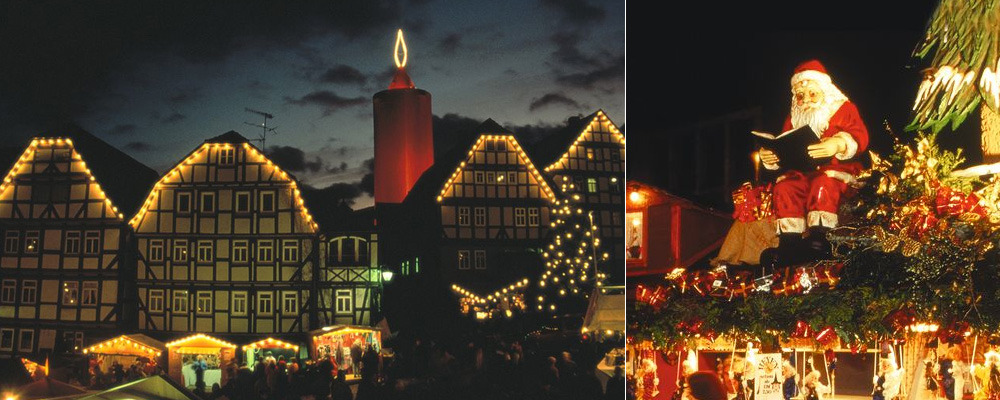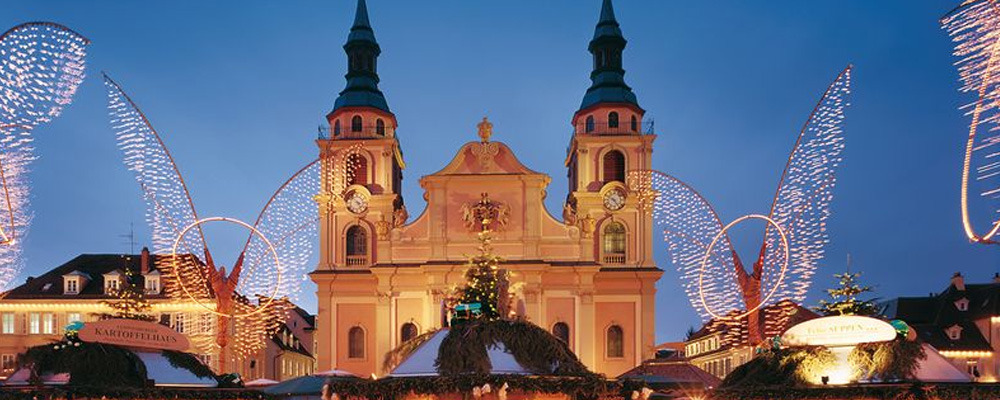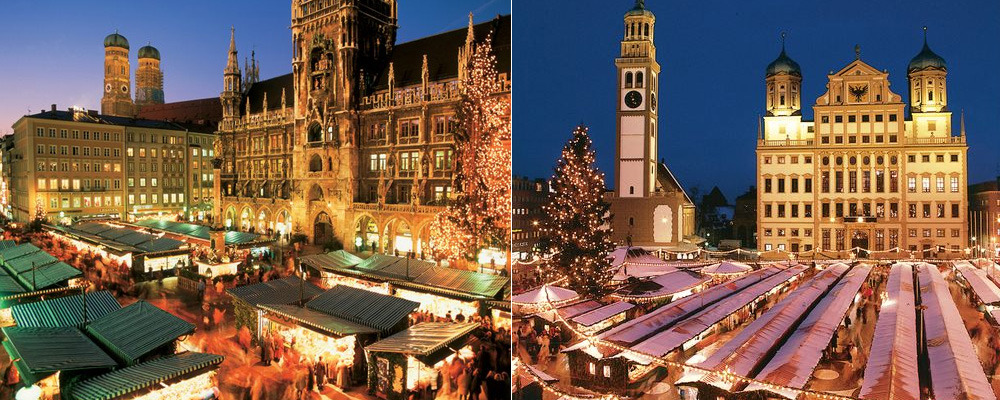Destination Deutschland: The Holiday Spirit of Germany’s Christmas Markets
Emily Manthei
Germany is a wonderful destination at any time of year, but Christmas-time is definitely a standout. The holiday season is filled with Christmas markets throughout the country’s towns and cities that thrive on remembering tradition. Germans still dig deep into the Prussian, Lutheran, Catholic and Central European traditions that have made the country what it is today.
A Christian holiday following a season called Advent, Christmas is the time to prepare for the arrival of Christianity’s most important figure. Christmas has been celebrated throughout Europe since the 4th century, by which time Christianity had become the dominant religion of the Byzantine and Roman Empires. Its timing amid the ancient pagan festival of winter solstice gave Christian converts all over Europe some ownership in the making of Christmas traditions. Gift-giving and greenery, for example, were solstice traditions that already existed among some Romans, while Yule logs and other foods were common seasonal traditions among Germanic peoples.
Contemporary German Christmas markets were common in European town squares and city streets, having originated in the Middle Ages in the Germanic-speaking parts of Europe (now known as Germany, Austria and the eastern regions of France and Switzerland). The markets sprung up in late November or early December and lasted through the four weeks of Advent, a time when the Christian church recounts with increasing hope and expectation the events that culminated in the birth of Christ. The Christmas “countdown” is represented in church with the lighting of four candles (for hope, peace, joy and love) during the weeks leading up to the holiday. When the central Christ candle is lit, elaborate Advent wreath sets and lights decorate Christmas market stalls while patrons are encouraged to join in the countdown at home with Advent calendars.
The use of greenery, such as evergreen wreaths and Christmas trees, once reminded pagans of the inevitable coming of spring after the dark and grueling days of early December. The evergreen trees remind Christians of the coming of the church season of Christ’s earthly life and ministry. Other popular Christmas market items are traditional German nutcrackers, wood-carved figurines (often used as Christmas tree decorations) and Nativity sets, with figurines representing Mary, Joseph and baby Jesus and the shepherds, angels and wise men surrounding them during the stable birth.
The food and drink found at the markets incorporate candied fruit and wintertime spices, like nutmeg and cinnamon. Drink the traditional mulled wine “Glühwein” or warm your spirits with some “egg punch” (known as “Eierpunsch” or eggnog). Roasted chestnuts, gingerbread cookies, candied almonds and a Christmas egg-bread called “stollen” are also popular seasonal treats at the markets. Take a journey from north to south while experiencing three styles of German Christmas markets in big cities and small towns.
Berlin
The German capital is home to 54 markets scattered across the city’s 12 boroughs. Although options abound, the WeihnachtsZauber is a Berlin favorite. Located between the Friedrichstrasse and Stadtmitte S-Bahn stations, you can find an impressive variety of handicraft makers, exhibitors and restaurateurs setting up shop starting on Nov. 27 and the market goes through Dec. 31. The best central-Berlin market near Alexanderplatz is Weihnachtszeit at Rotes Rathaus, where one of the city’s oldest, continuously running markets thrives under a bright neon Ferris wheel. Check out the Black Forest craft distillery Kleinbrennerei Fitzke to stock up on fruit brandies, liqueurs, grain spirits and whiskies for those cold, lonely nights. Weihnachtszeit Nov. 27 and the market goes through Dec. 30.
A quick sausage at Konnopke’s or a currywurst at any major Bahn is a must for all Berlin visitors — but that’s only the beginning of your culinary experience. Known for having haphazard, eclectic style and unpretentious, tucked-away entrances, some of Berlin’s restaurants are a bit different from five-star dining experiences in the U.S. Vegetarians should check out Cookies Cream, which is hidden in the service alley of the Westin Grand Hotel and up a flight of stairs into an industrial loft. The uber-hip speakeasy-style joint is so mysterious that you’ll wonder if the constantly changing menu is the only thing they’re hiding above the chandelier. Found inside a rather official-looking Georgian building, Tadshikische Teestube Tea Room is a cozy Russian restaurant that serves Tajik-inspired dishes and a variety of unique teas. Frau Mittenmang is halfway between your fashionable Grandma’s parlor-style dining room and an unfussy neighborhood brewpub. It also combines the unpredictable charm of Berlin’s eastside neighborhoods with the expertise of a world-class chef, serving boundary-pushing global eats that change daily. Be sure to plan ahead because reservations are a must. For nightlife check out the ever-changing hipster dance club Suicide Circus and SO36, Berlin’s legendary squat-turned-punk-club in Kreuzberg. And the monthly 1920s-styled gangster paradise known as Boheme Sauvage is a vintage dance-party must.
The home of atmospheric kitsch, Berlin provides a lot of options for bedding down. Starting at 30 euros a night, you can stay in Communist East Berlin (or at least a pretty close imitation of it). Ostel Hostel’s retro furniture, wallpaper and room designs give guests the opportunity to experience the DDR during its 30-ish years after World War II. If upscale Charlottenburg in West Berlin is more your style, Hotel-Pension Funk re-creates the elegance of the Art Nouveau period in the turn-of-the-century home of silent film star Asta Nielson. Two hotels boasting rooms for under 100 euros, Berlin’s thriving art scene is on full display at Arte Luise Kunsthotel, a 50-bed boutique with rooms designed by 50 artists, while the small art’otel chain offers three locations in Berlin. And luxury hotels like Das Stue, housed in the former Danish Embassy, and the West Berlin landmark Savoy cater to a trendy traveler’s need to be chic.
Dresden
Known as the oldest Christmas market in Germany, Dresden’s Striezelmarkt has been celebrated since 1434. Named after the southern German Christmas bread “Striezel,” the market is a great place for traditional German treats and handmade woodworking. The market season starts on November 27 with an opening ceremony and ecumenical service to mark the beginning of Advent. Throughout the season, weekly celebrations focus on a variety of traditions, such as a crowning a gingerbread princess; honoring chimney sweeps; and having a master baker cut a giant loaf of Stollen with a three-foot-long knife. This is the classic German Christmas celebrated by beloved children’s book characters, like the Whos.
From breakfast to cocktail hour, Cafe Continental has got you covered. The comfy, dimly lit atmosphere creates a casual-cool corner spot for the traditional German breakfast that’s served daily until 4 p.m. At Plan Wirtschaft, local, fresh ingredients and envelope-pushing dishes are standard fare within a stylish brick cellar that’s perfect for peaceful dining. Stilbruch is a cafe and bar that celebrates the surrealism of the 1930s and ’40s. It’s “The Cabinet of Dr. Caligari” meets “Twin Peaks” with a little Dali thrown in for good measure. For sophisticated craft cocktails or whiskey handpicked from 100 varieties, check out Karl May Bar (inside the Taschenbergpalais Hotel) or Frank’s Bar, a more unpretentious entry into expertly mixed cocktails.
Funky, Gaudi-inspired Backstage Hotel is an atmospheric choice that continues the illusion of vacationing in Whoville after your experience at the Striezelmarkt. For more upscale atmosphere, check out how Swissotel counterbalances its Medieval look with modern amenities, like a full-service spa. The previously mentioned Taschenbergpalais is also an excellent choice.
Rothenburg
In the heart of Bavaria, Rothenburg is a well-preserved medieval town that was deemed by Nazis to be “the most German town in Germany” (and, despite their infamous faults, the Nazis might just be right about this).Today’s Germans still appreciate the town’s quaint, medieval and Gothic architecture and the old-world charms of the cobblestone streets and red-roofed houses overlooking the Tauber River. The Rothenburg Reiterlesmarkt, which dates back to the 15th century, is similarly unchanged — or is it? The market is named after a legendary local fable about a ghostly horseman who scooped up the souls of the dead. Over the years the market took on a more Christian tone, and this mysterious rider turned into a friendly “Sleepy Hollow Santa Claus” creature who distributes gifts throughout the town. This year, the market will open on November 28 with the traditional Advent service.
Historical eating, drinking and sleeping are quite naturally the hallmarks of Rothenburg, a town steeped in its past. In the town’s oldest building, Zur Holl is a Franken-wine bar that serves up regional slow food and tasteful wine from nearby Würzburg. Also touting ancient origins on the “oldest street in Rothenburg,” Weinstube zum Pulverer is a wine bar that boasts simple, home-style Bavarian bread, soup and desserts. For more refined Franconian dining, check out Klosterstueble Restaurant, a lovely hotel and eatery with an eye towards popular local wines.
Moments away from the central square and Christmas market, Hotel Gotisches Haus is Rothenburg’s most charming boutique hotel with rooms that visitors rave about. The historic site retains a charming medieval feel in its restaurant and common areas, but its 11 rooms are pleasantly modern and updated. A more exclusive Rothenburg charmer, the Herrnschlösschen Hotel is inside one of the oldest houses in Germany, a nearly 1,000-year-old Bavarian masterpiece with rooms that exquisitely redefine luxury. The hotel offers “Vital Vault,” a spa and dry sauna for guests (included in the room costs), and a contemporary menu.
When all the celebrating is said and done, don’t forget to utter this seasonal salutation as you leave the market: “Frohe Weihnachten!”



